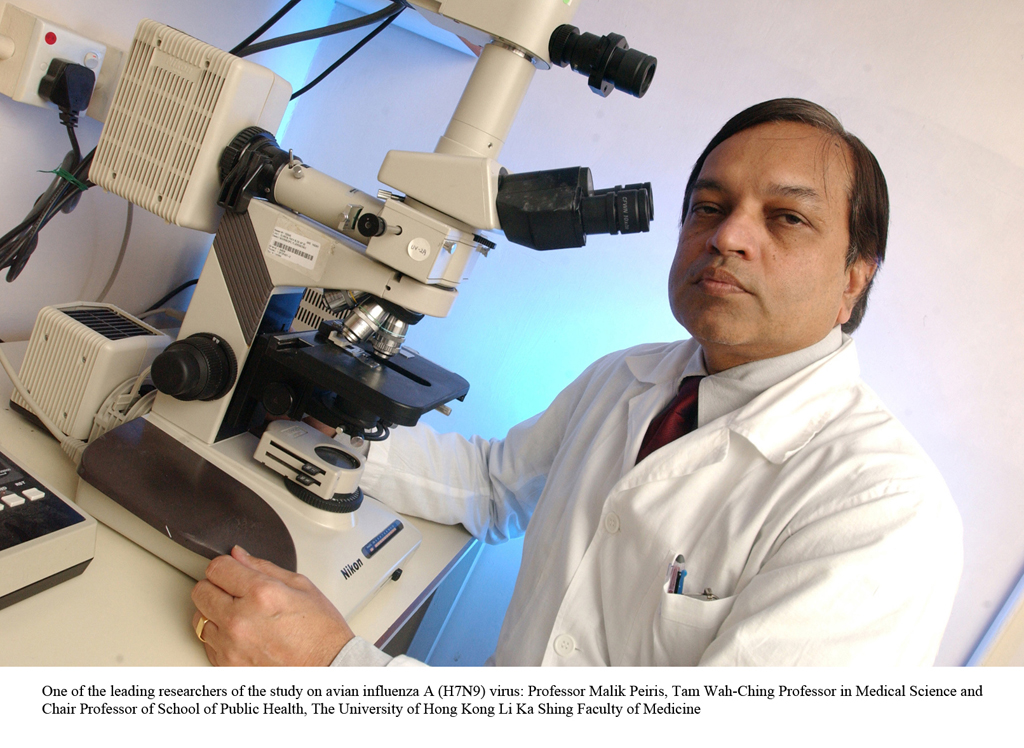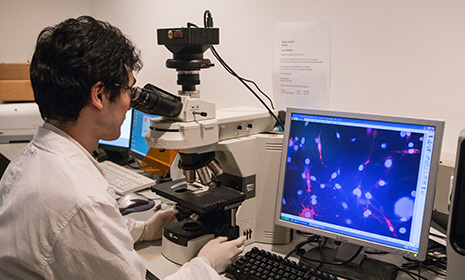A collaborative study between HKU and Fudan University to investigate the reasons for severe disease and death caused by H7N9 reveals that one factor is the emergence of virus resistance to Tamiflu
A collaborative study between the HKU and Fudan University, led by Professor Malik Peiris, Chair Professor of School of Public Health, The University of Hong Kong Li Ka Shing Faculty of Medicine, and Professor Yuan Zhenghong, Chair and Professor of Key Laboratory of Medical Molecular Virology at the Shanghai Medical College of Fudan University, provides one of the most detailed virological studies of avian influenza A (H7N9) virus disease in humans to date. They find the emergence of a virus mutation that allows the virus to become resistant to the antiviral drugs, named neuraminidase inhibitors (it includes Tamiflu, currently the main treatment option for H7N9) in patients who have a poor clinical outcome. This study highlights the need for early diagnosis and treatment of H7N9 disease, avoiding the use of corticosteroids and the need to monitor for the emergence of antiviral resistance. The research has just been published online in the prestigious international scientific journal, The Lancet.
Research Implications
Professor Malik Peiris, Tam Wah-Ching Professor in Medical Science and Chair Professor of School of Public Health, HKU Li Ka Shing Faculty of Medicine says, ?This study reveals that many patients do respond to the early use of antiviral drugs such as oseltamivir (Tamiflu) and highlights the need of early identification of H7N9 infected patients for prompt antiviral treatment. But we found that a poor outcome is associated with the development of virus mutations that lead to resistance to the commonly used antiviral drugs. ?
?The emergence of such resistance can probably be minimized by early diagnosis and treatment and by avoiding the use of high-dose corticosteroids in H7N9 patients.? says Professor Yuan Zhenghong of Fudan University who is a leader of this research.
Dr Yen Hui-ling, Assistant Professor of School of Public Health, HKU Li Ka Shing Faculty of Medicine, a co-author of the study says, ?The virus mutation found in this study is shown to make the H7N9 virus resistant to antiviral drugs in the test-tube. But because such mutations sometimes cripple the virus fitness and its ability to replicate, there is an urgent need for study on effects of this mutation on the virus.
Research Methodology and Key research findings
The researchers studied 14 patients who were admitted to the Shanghai Public Health Clinical Centre with confirmed H7N9 infection in April this year.
Following the expected course of H7N9 infection, all of the patients developed pneumonia. Seven of the patients became ill enough to require mechanical ventilation, and three further patients became so severely ill that they required extracorporeal membrane oxygenation (ECMO), which provides oxygen to the blood from outside the body when the lungs are not able to. Two of these patients died, and the third was still dependent on ECMO for survival at the time the paper was submitted.
By measuring each patients viral load (the quantity of virus in their body fluids, used as an indicator of virus severity) throughout the course of their illness, the researchers found that for most of the patients, treatment with a class of antiviral drugs called neuraminidase inhibitors ? a group which includes Tamiflu, and currently the main treatment option for H7N9 ? resulted in a reduction in the viral load found on throat swabs and was associated with clinical recovery. However, for the three patients who became severely ill, antiviral treatment did not reduce their viral load. Two of these patients showed emergence of a mutation in the H7N9 virus that allows it to become resistant to the antiviral drugs used in these cases.
Research Implications
This study provides the first evidence linking emergence of antiviral resistance with treatment failure and poor clinical outcome in H7N9 infected patients.
The researchers also analysed the viral load in all of the patients? throats, blood, stools and urine, finding traces of viral RNA in all of these areas for some patients. While the viral RNA detected is not necessarily infectious, and may have found its way into the digestive system via swallowed respiratory secretions, the researchers caution that further investigation is needed into whether H7N9 is able to spread beyond the respiratory tract.
Professor Malik Peiris further reiterates, ?Early treatment with antiviral drugs including oseltamivir currently proves the best option for recovery. However, the emergence of antiviral resistance to H7N9 viruses in some patients is concerning, it needs to be closely monitored and considered in future pandemic response plans.?
Professor Yuan Zhenghong says ?The appearance of the resistance mutation in drug treated patients does not mean that resistant viruses will transmit to other people?
About the research team
The research is led by Professor Malik Peiris, Chair Professor of School of Public Health, HKU Li Ka Shing Faculty of Medicine and Professor Yuan Zhenghong, Chair and Professor of Key Laboratory of Medical Molecular Virology at the Shanghai Medical College of Fudan University. Other key HKU researchers include Dr Yen Hui-ling, Assistant Professor, of School of Public Health, HKU Li Ka Shing Faculty of Medicine.










.png)
